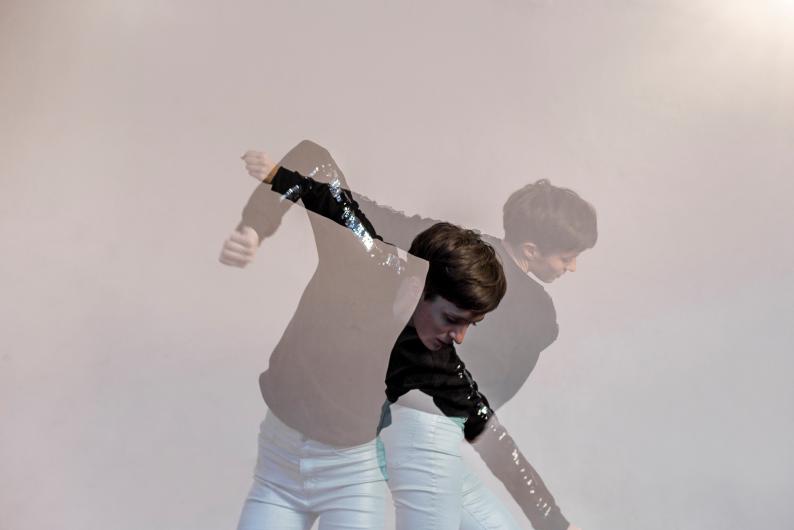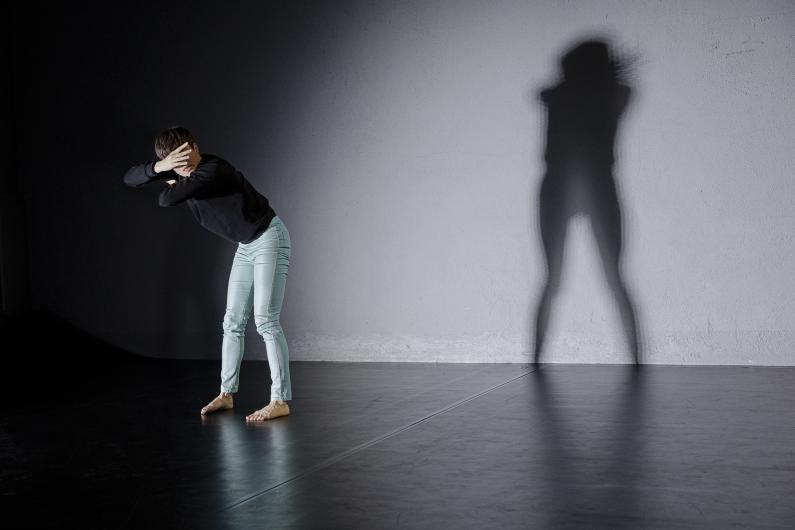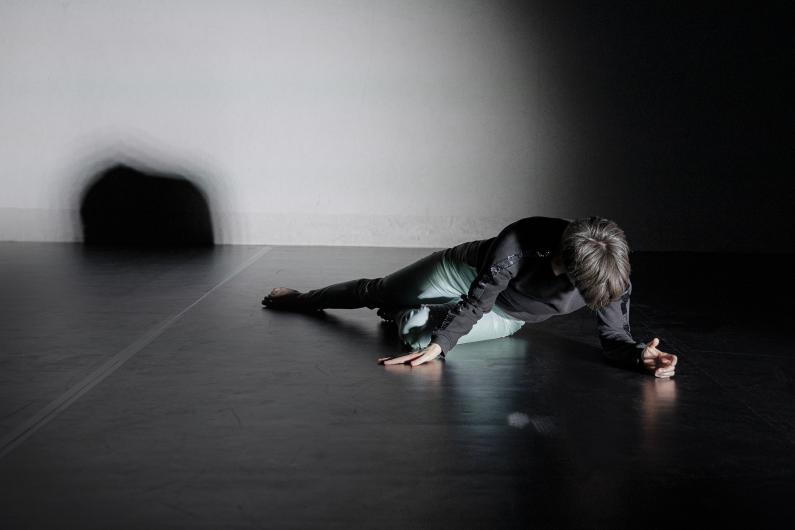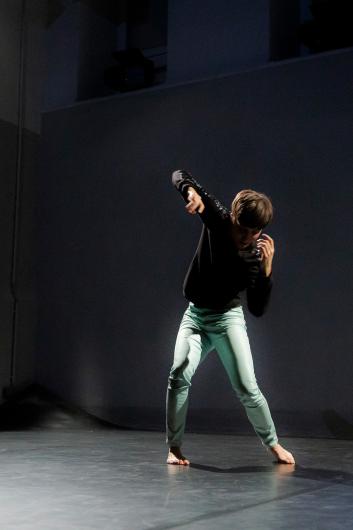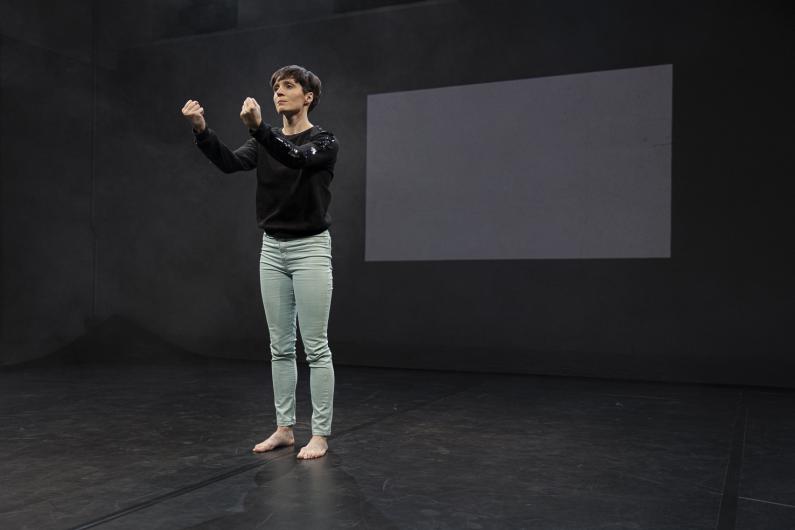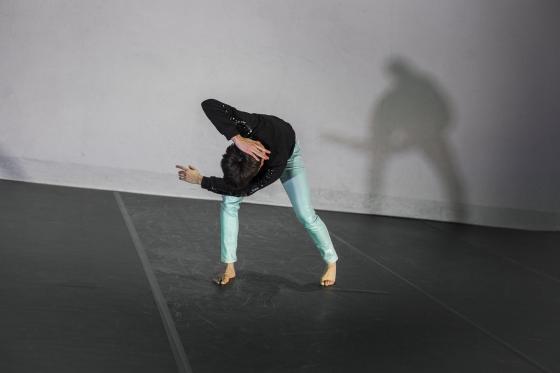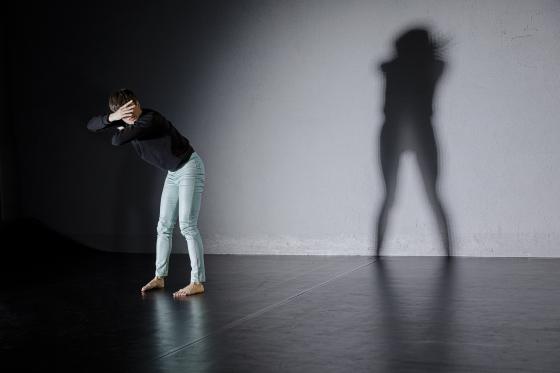varukt | Inge Gappmaier
protect. there is no wind in geometrical worlds
It is a Duet with herself that Inge Gappmaier stages in protect. there is no wind in geometrical worlds, creating a dance performance in an atmosphere full of hypnotic tension. Embedded in a haunting soundscape, she reflects questions about an isolated, narcissistic self and its (self-)reflection in a digital world. ELIZA, the first chatbot, created in 1966, that imitates a psychologist and guides users into a conversation with themselves, serves as particular inspiration.
protect. there is no wind in geometrical worlds centers around digital self-observation and the difference between mirror image, virtuality and physical reality. Embedded in a haunting, uncanny soundscape, Gappmaier puts the human body in its self-contemplation between nature and digitality on stage. Particular inspiration for this ‘duet with oneself’ is drawn from the first chatbot ELIZA, created by computer scientist Joseph Weizenbaum as early as 1966, who imitates a psychologist following the method by Carl Rogers and guides users into a conversation with themselves.
In her performance, Gappmaier picks up on practices of self-constitution in social media, filter bubbles and the associated algorithms as well as methods of self-optimization in our society, reflecting matters of protective spaces, control and power structures, loneliness, self-confinement and duality. The piece invites audiences to delve into a multi-dimensional world of geometry, accumulation and intuition. Following the lockdown-related online premiere during COVID in 2021, the stage version of protect. there is no wind in geometrical worlds will now finally be performed live for the first time in Vienna.
Inge Gappmaier works as a freelance choreographer, dancer, dance pedagogue, dramaturg and researcher. Through various artistic formats, she examines the contemporary conception of the human body between poetry, technology, history and the aesthetic impact of socio-political structures. She studied Choreography and Performance at the Institute for Applied Theatre Studies in Gießen (GER) and Contemporary Dance Education at the Music and Arts Private University of Vienna. She received various scholarships, teaches both amateurs and professionals, and is a board member for the IG Freie Theaterarbeit. In international collaborations, Gappmaier has presented her work, among other places, at brut Wien, Kosmos Theater, Tanzhafenfestival Linz, Plesni Teater Ljubljana, and the Albanian Dance Meeting. www.ingegappmaier.at
Robert Läßig and Inge Gappmaier have worked together for many years, starting at the Institute for Applied Theatre Studies in Giessen, and he also completed guest semesters in stage design at the HfG Offenbach, directing at the ZHdK Zurich and computer science at the THM Giessen. One focus of his work today is the exploration of the relationship between digitality and theatre. In a performative and theatrical context, he works as a lighting, video and interaction designer, with sensors, soldering irons, microcontrollers and source code. Robert Läßig was involved in productions at the Prague Quadrennial and the Treibstoff Theatertage. He recently worked with the composer Martin Grütter, the director Miriam Götz and the directing collective F.Wiesel, as well as a robot operator for Uncanny Valley by Rimini Protokoll. www.laessig.art
Pressestimmen
"Inge Gappmaier's body is one that can articulate its reflection on Weizenbaum's criticism with dance movements. All the more poetic now in its physical presence, with which Gappmaier even manages to put a light at the end of the present tunnel for the human-automat dilemma."
Helmut Ploebst (Der Standard)
Credits
Artistic direction & dance Inge Gappmaier Technical direction, lighting design & dramaturgy Robert Läßig Sound design Inge Gappmaier, Zsolt Bodoki-Halmen Dramaturgy Lisa-Marie Radtke, Stefanie Sommer Photography Natali Glisić Film version: Camera &Colour correction Lukas Schöffel Editing Maria Lisa Pichler
Special thanks to Gesa Bering, Stephan Dorn, Olivia Hild, Ricarda Sowa, Manuela Schaller, Martin Gappmaier
Thanks for the support to Fillimit@KoresponDance, Tranzit House and Reactor Cluj, Arbeitsplatz Wien, Im_Flieger und ttp WUK.
A co-production by varukt and imagetanz/brut Wien
Funded through the City of Vienna’s Department of Cultural Affair’s (MA 7) resumption funding
Dates & Tickets
January 2025
Choose your price category: € 22/€ 18/€ 14
Choose your price category: € 22/€ 18/€ 14 *Followed by an Artist Talk. Moderation: Katrin Brehm
Choose your price category: € 22/€ 18/€ 14
Choose your price category: € 22/€ 18/€ 14
studio brut
Zieglergasse 25, 1070 Wien
not accessible
Info
The performance on Fri. 24.01.2025 will be followed by an artist talk. Moderation: Katrin Brehm
Content Notes
This performance uses theatrical fog and occasionally blinding light.
Downloads
Abendprogramm_Inge Gappmaier_protect (PDF)
